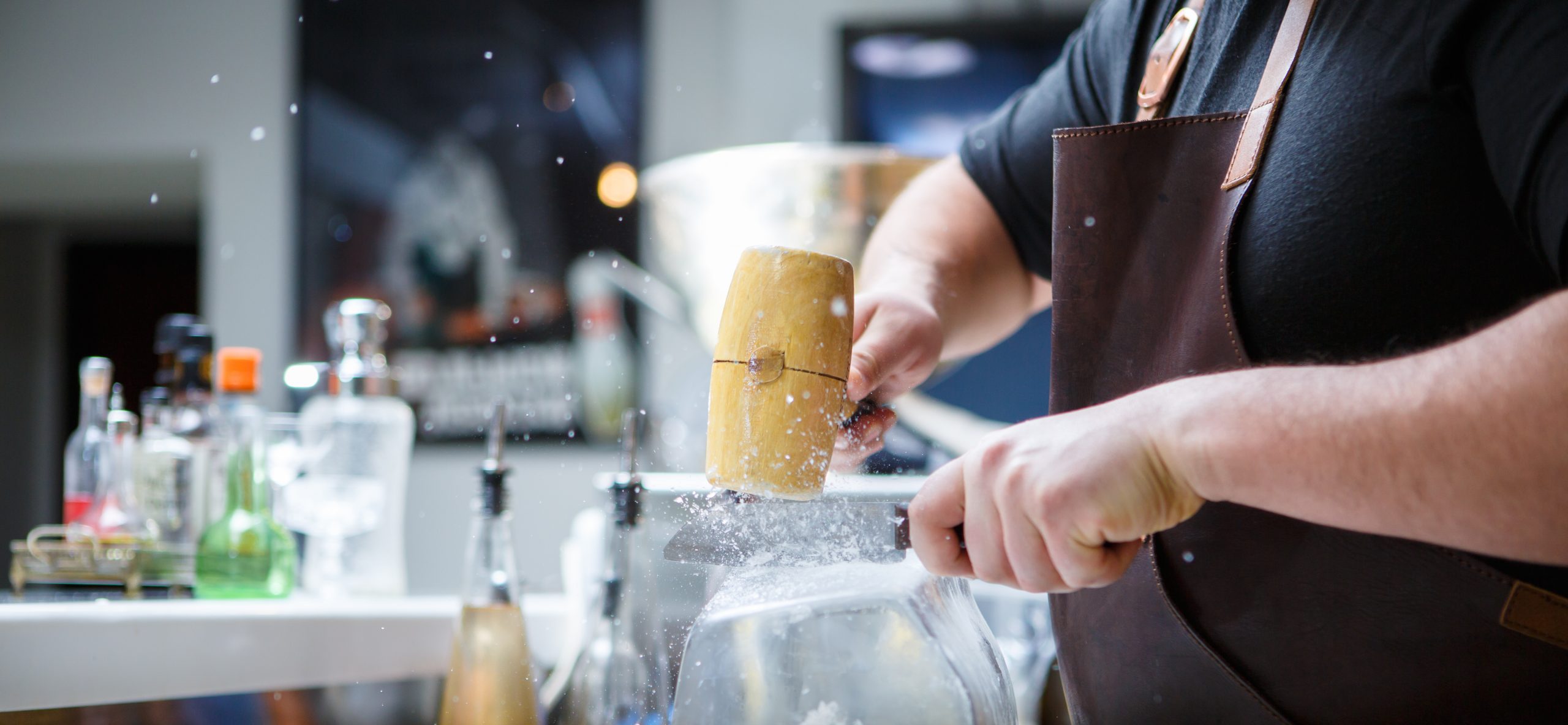


You probably think of liquor, liqueurs, vermouths, bitters, mixers, syrups, and garnishes. Your mind might default to the combination of bourbon, bitters, simple syrup, and orange peel for an Old Fashioned, or the gin, tonic water, and lime wedge you use to craft a Gin and Tonic.
Sure, these are essential cocktail components, but we can’t forget about the most prominent cocktail ingredient. It frequents 95% of cocktails and is, ironically, one of the most overlooked ingredients behind the bar.
Hint: It’s tasteless, clear, and basically free. (And no, it’s not a shot of well vodka).
With the exception of hot drinks and the interesting room temperature cocktail trend, ice is a core ingredient in every drink. Not only does ice chill a drink to its proper serving temperature (around 37-38˚F), but it’s also an important feature in its presentation. Plus, when ice melts, it helps bind together ingredients, smooth out flavor, and take the bite out of a base spirit.
As a bartender, ice should never be an afterthought. Either create your own, or find a vendor to purchase high quality ice from to complement your cocktails and create a better drinking experience for your customers.
When bartenders choose between large and small ice, they should think about how size affects a cocktail’s chilling, presentation, and dilution.
Generally, bartenders choose to use larger pieces of ice when they don’t want a spirit-forward cocktail or straight liquor to become too diluted. Larger pieces of ice have a lower surface-area-to-volume ratio, so they usually melt more slowly. This gives drinkers more time to finish their cocktail before the ice dilutes it. Keep in mind, since ice does not chill unless it also melts, larger ice cubes cool drinks more slowly than smaller ice cubes do.
In addition to their practical use, large pieces of ice are also popular for their unique look. Let’s face it—large-format ice pieces look sexier than your average plastic tray ice cubes. Include different types of large ice in your cocktails to dilute your drinks more slowly and capture the attention of your customers. Here are some common examples of large-format ice:
Rocks Ice
These ice pieces are usually square and tend to be around 2.25-2.5 inches in size. Because they’re bigger than standard mixing ice, they melt slowly and keep the drink cold for a longer period of time. Use this type of ice in a pure spirit, such as a bourbon or a spirit-forward drink like an Old Fashioned. To create rocks ice, use ice molds or cut them by hand. If you wish to buy it, reach out to artisanal ice companies.
Ice Ball
Ice balls, a staple in Japan, are now gaining popularity behind American bars. Because of their circular shape (usually 3 and 5 inches in diameter), they melt more slowly, dilute drinks less, and capture customers’ attention. You can create these spheres yourself by using a special mold or cutting them by hand. Or, if you wish to purchase them, you can order them from an artisan ice company.
Punch Ice or Block Ice
A big batch of punch calls for a big block of ice. Due to its size, punch ice can keep punch cold for a long period of time without watering it down too quickly. Punch ice is also commonly crafted in a donut shape or punch ring, which are only slightly smaller than the punch bowl. Often, these ice rings are decorated and infused with ingredients like citrus fruits.
Collins Spears or Shard Ice
If you’re looking to impress your customers, Collins spears are beautiful, elongated ice blocks specifically designed to fit into a Collins glass. Not only are they attractive, but they also take longer to melt and keep the drink chilled without over-diluting it. You can make these ice cubes with special long ice molds, by modifying silicone ice trays, or by hand-chipping large ice slabs. You can also purchase them from artisan ice companies.
As mentioned before, smaller ice cools and dilutes drinks faster. Because of this, if you’re crafting a highly concentrated drink like a Mint Julep or a Swizzle, you’ll want to use smaller ice to quickly chill the drink and water it down to make it immediately more drinkable.
Drinks like a Gin Martini aren’t served with ice but are stirred or shaken with small ice cubes and then immediately strained into a separate glass. This way, they are rapidly cooled with a small amount of controlled dilution to balance out the spirit.
Mixing Ice Cubes
Mixing cubes are used for stirring and shaking cocktails like the Martini. They’re also used in standard cocktails like a Rum and Coke or a Gin and Tonic. Generally, these ice cubes are a 1 inch square and can be made with a commercial ice machine (such as a Kold-Draft machine), ice molds, or by sectioning your own ice block. They can also be purchased from commercial ice companies.
Crushed or Pebbled Ice
Cocktails such as Rum Swizzles, Mint Juleps, and Tiki drinks call for crushed ice. Because they’re composed of juices and sweeteners, they need to be diluted faster. To make this type of ice, you can use a blender, purchase a crushed-ice maker, or go the old-school route and put ice cubes in a Lewis bag and hit them with a mallet or blunt object.
Cracked Ice
You might want to make a drink with ice that’s smaller than mixing cubes but not as granulated as crushed ice. Cracked ice makes it easier to smoothly mix a drink, and it offers a different presentation style. To make cracked ice, put ice in a Lewis bag and stop hitting it before the ice is totally crushed. You could also take each individual cube and whack it with a spoon until it cracks into smaller pieces.
If you’re planning to make your own ice, make sure you use the right kind of water. If you’re using high quality ingredients to make your cocktails, why would you make your ice cubes with ordinary tap water? Be sure to use pure, filtered water to ensure your final product is of high quality.
If you want to go the extra mile and make your ice cubes crystal clear, use the directional freezing method. Although cloudy ice is perfectly acceptable, clear ice adds a touch of elegance to a drink’s presentation. There are some commercial products that use the directional freezing method, but the simplest way to get this effect is to fill a clean thick-plastic cooler with pure, filtered water and put it in the freezer with the top off. Once the ice is done freezing, only the bottom 25% will be cloudy, so you’ll easily be able to cut this portion off.
As you can see, ice certainly deserves some attention. It affects a drink’s temperature, composition, and presentation. Make sure you carefully create or purchase high quality ice, and include the most appropriate type in each of your cocktails.
For more tips and tricks on cocktail development, check out our crafting cocktails page and subscribe to the blog!
Schedule 15mins to chat with a product specialist
Start a FREE Trial Today! BevSpot offers full product education and account setup for all customers! No card Information needed!
